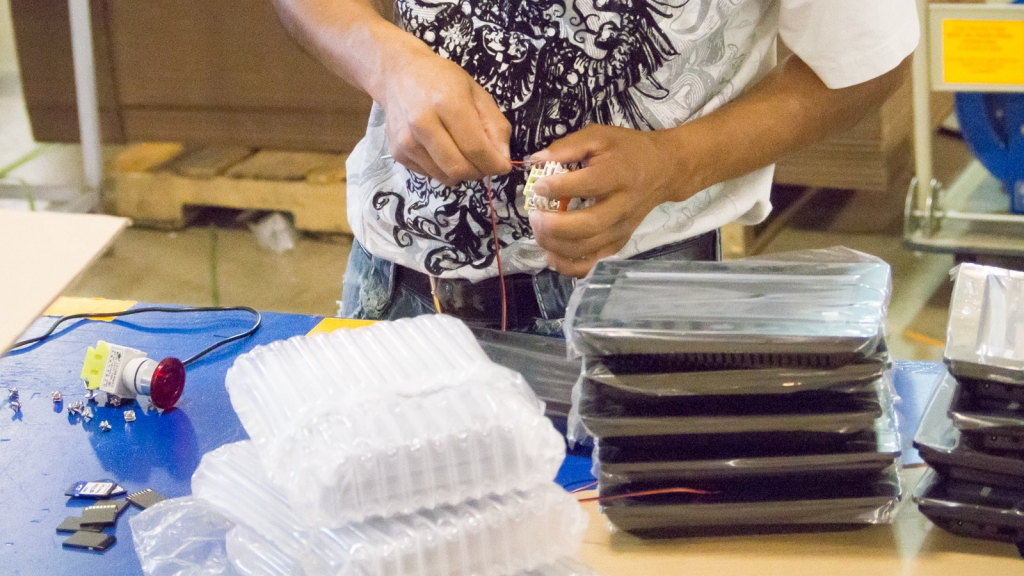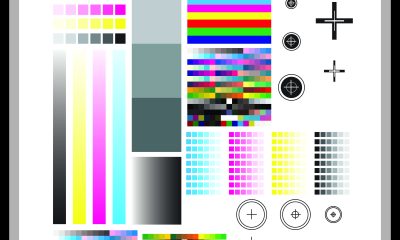Business & Industry
Published
11 years agoon

In the world of graphics manufacturing, how does one define P-O-P, besides using the words point-of-purchase? Perhaps the most effective way to define this fluid and ever-changing category is Shopper P-O-P, the eight-feet-and-below-eye-level signage—programs that must immediately draw shoppers to a particular product or brand. P-O-P means connection, education, and action.
In the world of graphics manufacturing, how does one define P-O-P, besides using the words point-of-purchase? Perhaps the most effective way to define this fluid and ever-changing category is Shopper P-O-P, the eight-feet-and-below-eye-level signage—programs that must immediately draw shoppers to a particular product or brand. P-O-P means connection, education, and action.
P-O-P programs take on various forms inside the retail space, from meaningful shelf- mounted, static signs to creating engaging experiences with integrated, dynamic displays. Effective P-O-P providers work hand in hand with retailers and product-brand managers to anticipate customer needs, develop solutions to capture customer attention and gain customer loyalty, and ultimately deliver increased market share through innovative, effective, and targeted merchandising, promotional, and seasonal campaigns.
Successful partnerships between providers and clients involve brand and consumer insights, creative design services, store-specific rollouts, value engineering, multifaceted print production, inventory management, distribution, and installation.
It’s a shopper’s market
It is no secret that retailers and manufacturers have had an ongoing power struggle when it comes to competing for space and choosing promotions. In more recent times, we have seen shifts within the marketplace that are forever changing the dynamics of the relationships between retailers and consumer product brand suppliers. Undoubtedly, it is a shopper’s market and, ultimately, the power starts and ends with the consumer.
Despite the online shopping component infringing on the brick-and-mortar experience, there is strong evidence that shoppers are still heading to physical stores to feed their senses with the ability to touch, test, and see end products. These habitual behaviors have been created over a long time and will continue to benefit retailers and the experience they provide through consumer product companies, which is why it is more important than ever to grab customers’ attention quickly and inspire them to act while you have their attention in the store.
This has resulted in more collaborative partnerships between the retailers and consumer-product-goods companies, which make the role of the P-O-P provider even more important. Retailers are requiring more from their brand manufacturers to deliver value and to maximize profits within their retail environments. That’s why it’s important to understand the nuances of the role P-O-P plays with the consumer and how to translate that to connect consumers with retailers and product brands in unexpected ways.
New strategies and opportunities abound for creating more educational and interactive categories through end-cap promotions. When retailers and consumer-product-good companies work together, the result exceeds consumer expectations and inspires them at the point of purchase.
An example of collaboration
Lowe’s U.S. is one of Pratt’s long-standing partners. The company’s Merchandising and Store Environment teams commissioned our Shopper P-O-P division to execute print manufacturing, product assembly, and custom kit-packing for their Tool World Kobalt promotional end-cap program (Figures 1A-1D). The program is part of an integrated technology component and features Kobalt tools with supporting temporary P-O-P fixtures and graphics. The fixture and technology components had to be shelf-ready upon arrival to the stores, and the turnaround timeline was aggressive.
A variety of services and prototype solutions were commissioned so Lowe’s might assess the print quality and integrity of the temporary P-O-P fixtures prior to distribution. Upon final approval, we created custom pack teams to manage quality control, product testing, and full assembly of the store’s specific display units. The program included screen printing, custom carton design, custom pack teams to manage store-specific pack-out, product consolidation, and shipping to Lowe’s retail stores throughout the U.S.
The intent of Lowe’s U.S. featuring this Tool World Kobalt promotional end cap was to connect with their consumers in a new way by drawing them seamlessly to the products and then allowing hands-on interaction to test the product in its actual application. This end-cap experience embodies the unique attributes that are still driving consumers into brick-and-mortar stores for a more meaningful and interactive shopping encounter.
End-in-mind design
Some P-O-P programs or product launches require creative, graphic-design, or product-engineering capabilities. Other programs have already been designed or specified. Either way, end-in-mind designs create lasting connections with shoppers.
For example, Festool’s product marketing commissioned Pratt’s Retail Studio to develop a graphic-communications program featuring their Planex Drywall tool and accessories product with end-in-mind solutions (Figure 2). Our creative team assisted in design, product-material specifications, hardware solutions, and merchandise planogramming. The display’s design fitment required a seamless graphic integration, maximizing Festool’s product design, packaging; brand key features, and their target consumer.
The in-store program required a holistic, yet simplified, product planogram and graphic-implementation guide for ease of fitment and installation across existing single bay fixtures in diverse dealer locations.
The Planex program included a variety of digitally printed items, display systems, and hardware elements; consolidation of client-supplied items; kitting; and shipping to various dealer locations throughout the U.S. We took a single bay existing in a Festool store-within-a-store environment and took a form-and-fit approach, where P-O-P elements helped to create excitement and buzz for a new product launch, engaging the consumer and enhancing the shopping experience.
The cost of cutting costs
Many P-O-P programs have specified P-O-P signage components, where form and fit and how to engineer, produce, package, and distribute are critical. Price is usually the driver for acceptance; sometimes, reverse auctions are used as a specific tool. Buying groups are particularly adept at applying these techniques. While this approach does drive down initial cost, it doesn’t necessarily lead to continual improvement over time. The only way to accomplish this is through process-value engineering and supply-chain improvement.
Effective P-O-P providers maintain a team of highly skilled retail experts who oversee every project from inception to delivery and who provide a steady flow of communication between the customer and their program. These companies also have project managers on staff who own the projects and deliver with results.
Managing all variables of retail-graphics production is vital to producing a sound product that delivers confidence to customers. The realization process should include materials specialists who production-engineer every fixture and display with the attitude of a scientific lab technician. Each design should also be value-engineered to ensure a durable, cost-effective product for the brand customer.
The last piece of the development stage is the management of sourcing partners. Building long-standing value-chain partnerships with similar industry leaders, nationally and internationally, is very important.
Muscle and merit―litho, screen, or digital
Many complex, multi-product P-O-P kit projects require a combination of print capabilities due to graphic reproduction, quantity and color requirements. In some cases, there could be a trade-off price versus quality, particularly if the project is bought on price only. If you’re operating a full-service business and haven’t looked into certifications for printing, now’s the time.
If your business has the ability to print with screen, digital, and/or litho presses, you should get on board with G7 certification so that you can expertly manage color across various substrates and printing techniques and ensure the best quality and price are achieved.
Uncovering indirect costs
Nearly all P-O-P projects have set budgets focusing on the direct costs of signage elements. Most do not focus on the indirect costs, overproduction and waste, form and fit inside the store, shipping logistics, inventory requirements. In many cases, the indirect costs—over production, accelerated freight, poor packaging/consolidation—are substantial, leading to poor overall value.
The constantly changing nature of retail sales is a barrier to some production firms. Consider developing a fully integrated online system that houses unique, store-specific attributes so that you can ship store-specific elements and ensure no over/under production. Additionally, you should employ lean processes that allow for a flexible fulfillment schedule that ends up saving your clients time and money.
Keep no more than three months of inventory on hand at all times. This provides low risk for your customers and minimal obsolescence of product. Use technology to our benefit in replenishment services, but always work hand in hand with clients to build a custom solution.
Moving consumers at retail
Creating signage and impactful store environments for some of the world’s largest brands means operating at a level beyond just being a provider of services. Be a business people your customers can relate to, and create partnerships in which you work closely to design a process that fits flush with your needs. Finally, remember that delivering a seamless in-store environment is the best way to deliver a truly memorable shopping experience.

Subscribe

Magazine
Get the most important news
and business ideas from Screenprinting Magazine.
Most Popular
-

 Case Studies2 months ago
Case Studies2 months agoHigh-Density Inks Help Specialty Printing Take Center Stage
-

 Art, Ad, or Alchemy2 months ago
Art, Ad, or Alchemy2 months agoF&I Printing Is Everywhere!
-

 Andy MacDougall2 months ago
Andy MacDougall2 months agoFunctional and Industrial Printing is EVERYWHERE!
-

 Columns3 weeks ago
Columns3 weeks ago8 Marketing Mistakes Not to Make When Promoting Your Screen Printing Services Online
-

 Editor's Note2 weeks ago
Editor's Note2 weeks agoLivin’ the High Life
-

 Marshall Atkinson2 weeks ago
Marshall Atkinson2 weeks agoHow to Create a Winning Culture in Your Screen-Printing Business
-

 Thomas Trimingham2 months ago
Thomas Trimingham2 months ago“Magic” Marketing for Screen Printing Shops
-

 News & Trends2 months ago
News & Trends2 months agoWhat Are ZALPHAS and How Can You Serve Them in Your Print Business?






